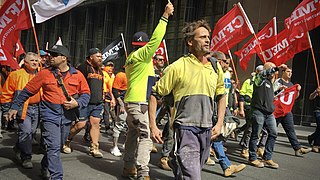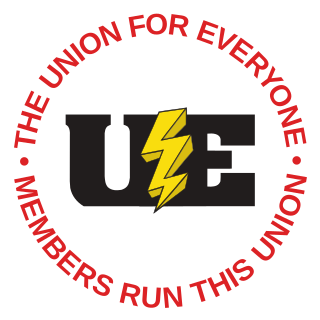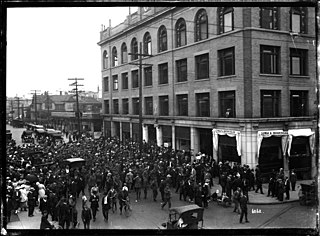Related Research Articles
A trade union or labor union, often simply referred to as a union, is an organization of workers whose purpose is to maintain or improve the conditions of their employment, such as attaining better wages and benefits, improving working conditions, improving safety standards, establishing complaint procedures, developing rules governing status of employees and protecting and increasing the bargaining power of workers.
Labour laws, labour code or employment laws are those that mediate the relationship between workers, employing entities, trade unions, and the government. Collective labour law relates to the tripartite relationship between employee, employer, and union.

Strike action, also called labor strike, labour strike in British English, or simply strike, is a work stoppage caused by the mass refusal of employees to work. A strike usually takes place in response to employee grievances. Strikes became common during the Industrial Revolution, when mass labor became important in factories and mines. As striking became a more common practice, governments were often pushed to act. When government intervention occurred, it was rarely neutral or amicable. Early strikes were often deemed unlawful conspiracies or anti-competitive cartel action and many were subject to massive legal repression by state police, federal military power, and federal courts. Many Western nations legalized striking under certain conditions in the late 19th and early 20th centuries.
Industrial relations or employment relations is the multidisciplinary academic field that studies the employment relationship; that is, the complex interrelations between employers and employees, labor/trade unions, employer organizations, and the state.
Collective bargaining is a process of negotiation between employers and a group of employees aimed at agreements to regulate working salaries, working conditions, benefits, and other aspects of workers' compensation and rights for workers. The interests of the employees are commonly presented by representatives of a trade union to which the employees belong. A collective agreement reached by these negotiations functions as a labour contract between an employer and one or more unions, and typically establishes terms regarding wage scales, working hours, training, health and safety, overtime, grievance mechanisms, and rights to participate in workplace or company affairs. Such agreements can also include 'productivity bargaining' in which workers agree to changes to working practices in return for higher pay or greater job security.

The United Auto Workers (UAW), fully named International Union, United Automobile, Aerospace and Agricultural Implement Workers of America, is an American labor union that represents workers in the United States and southern Ontario, Canada. It was founded as part of the Congress of Industrial Organizations (CIO) in the 1930s and grew rapidly from 1936 to the 1950s. The union played a major role in the liberal wing of the Democratic Party under the leadership of Walter Reuther. It was known for gaining high wages and pensions for automotive manufacturing workers, but it was unable to unionize auto plants built by foreign-based car makers in the South after the 1970s, and it went into a steady decline in membership; reasons for this included increased automation, decreased use of labor, mismanagement, movements of manufacturing, and increased globalization. After a successful strike at the Big Three in 2023, the union organized its first foreign plant (VW) in 2024.
In labor law, a union shop, also known as a post-entry closed shop, is a form of a union security clause. Under this, the employer agrees to either only hire labor union members or to require that any new employees who are not already union members become members within a certain amount of time. Use of the union shop varies widely from nation to nation, depending on the level of protection given trade unions in general.
A union security agreement is a contractual agreement, usually part of a union collective bargaining agreement, in which an employer and a trade or labor union agree on the extent to which the union may compel employees to join the union, and/or whether the employer will collect dues, fees, and assessments on behalf of the union.

A sit-down strike is a labour strike and a form of civil disobedience in which an organized group of workers, usually employed at factories or other centralized locations, take unauthorized or illegal possession of the workplace by "sitting down" at their stations. By taking control of their workplaces, workers engaged in a sit-down demonstrate their power, build solidarity among themselves, prevent the deployment of strikebreakers or removal of industrial equipment, and cause cascading effects on the chain of production within and between factories. However, sit-down strikes are illegal in the vast majority of countries, complicating their use.
Pattern bargaining is a process in labour relations, where a trade union gains a new and superior entitlement from one employer and then uses that agreement as a precedent to demand the same entitlement or a superior one from other employers.

The United Electrical, Radio and Machine Workers of America (UE), is an independent democratic rank-and-file labor union representing workers in both the private and public sectors across the United States.
Mexican labor law governs the process by which workers in Mexico may organize labor unions, engage in collective bargaining, and strike. Current labor law reflects the historic interrelation between the state and the Confederation of Mexican Workers, the labor confederation officially aligned with the Institutional Revolutionary Party, which ruled Mexico under various names for more than seventy years.

Labor unions represent United States workers in many industries recognized under US labor law since the 1935 enactment of the National Labor Relations Act. Their activity centers on collective bargaining over wages, benefits, and working conditions for their membership, and on representing their members in disputes with management over violations of contract provisions. Larger labor unions also typically engage in lobbying activities and electioneering at the state and federal level.

Union busting is a range of activities undertaken to disrupt or weaken the power of trade unions or their attempts to grow their membership in a workplace.

Graduate student employee unionization, or academic student employee unionization, refers to labor unions that represent students who are employed by their college or university to teach classes, conduct research and perform clerical duties. As of 2014, there were at least 33 US graduate employee unions, 18 unrecognized unions in the United States, and 23 graduate employee unions in Canada. By 2019, it is estimated that there were 83,050 unionized student employees in certified bargaining units in the United States. As of 2023, there were at least 156 US graduate student employee unions and 23 graduate student employee unions in Canada.

Labor relations or labor studies is a field of study that can have different meanings depending on the context in which it is used. In an international context, it is a subfield of labor history that studies the human relations with regard to work in its broadest sense and how this connects to questions of social inequality. It explicitly encompasses unregulated, historical, and non-Western forms of labor. Here, labor relations define "for or with whom one works and under what rules. These rules determine the type of work, type and amount of remuneration, working hours, degrees of physical and psychological strain, as well as the degree of freedom and autonomy associated with the work." More specifically in a North American and strictly modern context, labor relations is the study and practice of managing unionized employment situations. In academia, labor relations is frequently a sub-area within industrial relations, though scholars from many disciplines including economics, sociology, history, law, and political science also study labor unions and labor movements. In practice, labor relations is frequently a subarea within human resource management. Courses in labor relations typically cover labor history, labor law, union organizing, bargaining, contract administration, and important contemporary topics.
A collective agreement, collective labour agreement (CLA) or collective bargaining agreement (CBA) is a written contract negotiated through collective bargaining for employees by one or more trade unions with the management of a company that regulates the terms and conditions of employees at work. This includes regulating the wages, benefits, and duties of the employees and the duties and responsibilities of the employer or employers and often includes rules for a dispute resolution process.
A whipsaw strike is a strike by a trade union against only one or a few employers in an industry or a multi-employer association at a time. The strike is often of a short duration, and usually recurs during the labor dispute or contract negotiations—hence the name "whipsaw".
SEIU Member Activists for Reform Today (SMART) is a national organization of rank-and-file union members working for the democratic reform of the Service Employees International Union (SEIU). SEIU primarily represents workers in the public sector, healthcare industry, and property services. Today it is America's largest and fastest growing union with 2 million members, many of whom are minorities, immigrants, and women.
Collective agreement coverage or union representation refers to the proportion of people in a country population whose terms and conditions at work are made by collective bargaining, between an employer and a trade union, rather than by individual contracts. This is invariably higher than the union membership rate, because collective agreements almost always protect non-members in a unionised workplace. This means that, rather than individuals who have weaker bargaining power representing themselves in negotiations, people organise to represent each other together when negotiating for better pay and conditions in their workplace. The number of people who are covered by collective agreements is higher than the number of union members, and in many cases substantially higher, because when trade unions make collective agreements they aim to cover everyone at work, even those who have not necessarily joined for membership.
References
- 1 2 3 Najita, Joyce, and Roberts, Harold S. Roberts' Dictionary of Industrial Relations. Washington, D.C.: BNA Books, 1994. ISBN 0871797771
- 1 2 Rainsberger, Paul K. (n.d.). "Historical Models of Collective Bargaining in the U.S." Collective Bargaining. University of Missouri Labor Education Program. Archived from the original on 2008-04-12. Retrieved July 30, 2008.
- ↑ Korea Shipping Corporation v. New York Shipping Association-International Longshoremen's Association Pension Trust Fund, 880 F.2d 1531 (1989).
- ↑ Hardin, Patrick; Higgins Jr, John E.; Hexter, Christopher T.; and Neighbours, John T. The Developing Labor Law: The Board, the Courts, and the National Labor Relations Act. 4th ed. Washington, D.C.: BNA Books, 2002. ISBN 1-57018-151-9; Williams, Steve and Adam-Smith, Derek. Contemporary Employment Relations: A Critical Introduction. Oxford, England: Oxford University Press, 2005. ISBN 0-19-927243-3
- 1 2 Levin, Doron P. "Chrysler Makes Plea To U.A.W." New York Times. July 21, 1990.
- ↑ Brus, Brian. "Bridgestone/Firestone, Union Negotiators Reach Master Contract." Oklahoma City Journal Record. June 10, 2005.
- ↑ Todd, Kris. "Spencer Teachers' 2008–09 Master Contract Ratified." Spencer Daily Report. May 9, 2008.
- ↑ Cimini, Michael H. and Muhl, Charles J. "Master Contract at Philip Morris." Monthly Labor Review. May 1995.
- ↑ Pryor, Alex. "OneSource, SEIU Union Reach Contract for Tufts Janitors." Tufts Daily. September 22, 2004.
- ↑ Rauber, Chris. "CHW Hospitals Deliver Union Contract After Short Labor." San Francisco Business Times. April 25, 1997.
- ↑ Brisbin Jr., Richard A. A Strike Like No Other Strike: Law and Resistance During the Pittston Coal Strike of 1989–1990. Baltimore, Md.: Johns Hopkins University Press, 2002. ISBN 0-8018-6901-3.
- 1 2 Royle, Tony and Towers, Brian. Labour Relations in the Global Fast-food Industry. New York: Routledge, 2002. ISBN 0-415-22167-6
- ↑ "USWA Names Goodyear Target for Master Contract Talks." Rubber & Plastics News. April 14, 2003; Freeman, Sholnn. "Union Picks GM to Lead Contract Talks." Washington Post. September 14, 2007.
- ↑ Yates, Charlotte. "Expanding Labour's Horizons: Union Organizing and Strategic Change in Canada." Just Labour. 2002.
- 1 2 3 Kutalik, Chris (July 2003). "Two Unions Enter Recognition Pact with Health Care Company". Labor Notes.
- ↑ Fairbrother, Peter and Yates, Charlotte. Trade Unions in Renewal: A Comparative Study. New York: Routledge, 2003. ISBN 0-8264-5437-2
- ↑ The claim is that by permitting thousands or even tens of thousands of members to vote on a contract, the master contract makes it impossible for the contract's opponents to muster enough votes across all workplaces to defeat the contract. For an example, see: Biers, Carl; Niemeijer, Marsha (June–July 2004). "Dockworkers Campaign Against ILA Master Agreement". Union Democracy Review.
- ↑
- Gaus, Mischa (April 2008). "Quiet Deal Leads to Bitter Fight in Ohio Hospitals". Labor Notes.
- Brenner, Mark (March 2008). "Health Care Local Charges SEIU Is Shutting Members Out of Bargaining & Organizing". Labor Notes.
- White, Ronald D. (August 3, 2003). "Unions Battle for Nurses". Los Angeles Times.
- Lando, Tamar (September 25, 2003). "Union Triage". L.A. Weekly.
- Kaplan, Esther (June 16, 2008). "Labor's Growing Pains". The Nation.
- ↑ Murray, Jill. "Work Choices and the Radical Revision of the Public Realm of Australian Statutory Labour Law." Industrial Law Journal. December 2006.